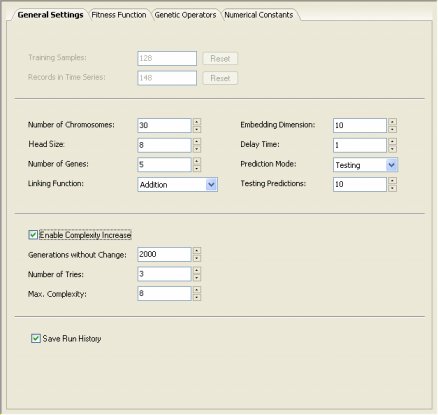| The General Settings Tab gives access to the
following settings and features:

Training Samples
Number of samples used for training. This box is informative only as the number of training
samples depends on the parameters chosen to transform the time
series such as Embedding Dimension, Delay Time, Prediction Mode, and
the number of Testing Predictions.
Records in Time Series
This box is informative only and shows the number of records in
the current time series.
Number of Chromosomes
Size of the population of models created each generation for breeding new ones.
Head Size
Size of the head
of each gene. This parameter determines the upper limit for the size of the programs encoded in the gene.
Number of Genes
Number of genes per chromosome or, in other words, the number of complex terms in the evolving models.
Linking Function
Function used to link the different terms encoded in the genes of a model. You can choose either addition, subtraction, multiplication, or division to link the
sub-ETs of your models.
Embedding Dimension
The embedding dimension used to transform the time series for training. It corresponds to the number of independent variables after the transformation of the time series.
Delay Time
The value of the delay time t, which determines how data are processed, that is, continuously if
t = 1 or at t
intervals.
Prediction Mode
Lists the two kinds of recursive predictions you can do in GeneXproTools:
Prediction and Testing. The first one is used for making predictions about the future.
And the second is used for evaluating the predictive power of the evolved models on past known events. In both cases, predictions are made
recursively by evaluating the forecast at
t+1, then using it to forecast t+2, and so on.
Testing Predictions
This box becomes active when Testing is selected in the
Prediction Mode list box. Here you must enter the number of samples you want to
reserve for the recursive test.
Enable Complexity Increase
Check this box if you wish to allow GeneXproTools to automatically increase the number of genes in the evolving models.
Generations without Change
The period of time you think acceptable for evolution to occur without improvement in best fitness, after which
a mass extinction is created or a neutral gene (an extra term) is automatically added to all evolving
models.
Number of Tries
The number of consecutive evolutionary epochs (defined by the
parameter Generations Without Change) you will allow before a neutral gene is introduced in all evolving models.
Max. Complexity
The maximum number of terms (genes) you think reasonable for modeling your data. Beyond this threshold no other terms are introduced automatically by the Complexity Increase Engine and
GeneXproTools stops evolving new models.
|